
- SAP SRM - Home
- SAP SRM - Overview
- SAP SRM - Navigation
- SAP SRM - Functions
- SAP SRM - Software Components
- SAP SRM - Deployment Options
- SAP SRM - Contract Management
- SAP SRM - Creating Central Contract
- SAP SRM - Bid Invitation
- Quotation & Live Auction Cockpit
- SAP SRM - Procurement
- Invoicing And Purchase Order
- SAP SRM - Shopping Cart
- SAP SRM - Supplier Self-Service
- SAP SRM - Post Installation For LAC
- Configuring Single Sign-on
- SAP SRM - Supplier Evaluation
- SAP SRM - MDM Catalog Upgrade
- SAP SRM - Security
- SAP SRM - System Landscape
- Network & Communication Security
- SAP SRM - Auditing & Logging
SAP SRM - Contract Management
In SAP SRM, a contract is defined as a negotiation between a supplier and an organization for supply of goods and material or delivery of services within defined terms and conditions in a specific time period. These contracts are placed at central secure location to resolve the lack of visibility into contract across the different groups.
This allows you to manage different local contracts with different terms and conditions for similar type of goods.
CCM allows buyers form different departments of company from different locations to take advantage of negotiated terms and conditions. The terms and conditions are transitioned into a central contract and to be distributed to local purchasing group to perform procurement process for the company.
SAP SRM provides the following CCM features −
SAP SRM helps you to improve and fasten procurement process by automating and streamlining the contract management process.
SAP SRM helps you to automate transfer of global negotiated conditions into multiple ERP systems and into non-SAP solutions using Enterprise Services.
SAP SRM allows you to ensure contract compliance by providing a repository of standard contracts that can be used for creating new contracts.
You can easily create or change a central contract by directly negotiating with suppliers or by creating RFx.
Using CCM, you can control access to central contract using the assignment of authorization on central repository.
You can also configure system to generate alerts for the expiring contracts, etc.
You can customize central contract distribution as per your needs and it can be an individual contract or multiple contracts for the same category.
Integration with SAP ERP to Upload Contracts
To upload the central contracts and to schedule agreements from SAP ERP system to SAP SRM system, you can use program BBP_CONTRACT_INITIAL_UPLOAD. As per your configuration, these contracts are loaded and scheduled from ERP to SAP SRM system.
The initial upload is supposed to be a one-time activity and is performed at the time of installation in the backend system.
To perform contract search, you can use TREX search engine. This search engine is provided with SAP SRM but you have to install it and run a program to create indexing for all the available contracts. You should run program BBP_TREX_INDEX_ADMIN that creates a new index for existing documents and helps you to perform indexing for all new or changed documents when a contract is saved.
You can also evaluate your contracts by creating BI reports when you integrate with SAP NetWeaver Business Intelligence.
To generate BI reports, go to SAP NetWeaver → BI Content → Supplier Relationship Management → Contract Management.
Change History in Central Contract Management
You can also view change documents available for all the fields in Central Contract Management (CCM) and they are used for audit trial. You can compare the versions of a contract by comparing changes at item and header level between these versions.
Let us follow these steps to compare the versions −
Step 1 − To perform this, go to SRM Server → Cross Application Basic Settings → Switch on version control for purchasing documents.
Step 2 − Login to SRM system as in the following screenshot using SAP GUI.
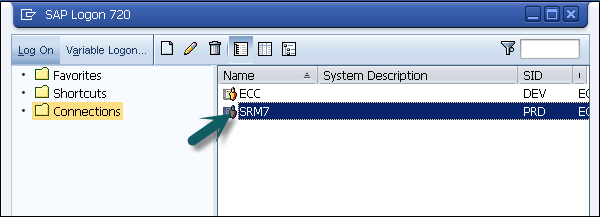
Step 3 − Type SPRO → IMG → Navigate to SRM Server → Cross Application Basic Settings.
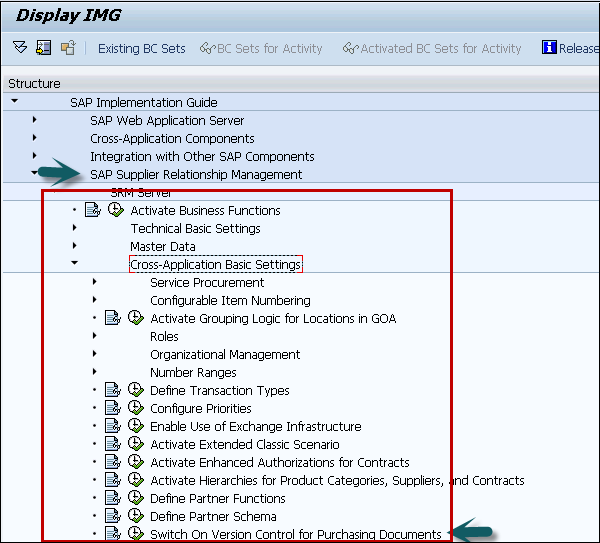
Step 4 − You can view all business transaction categories for which version control is on/off.
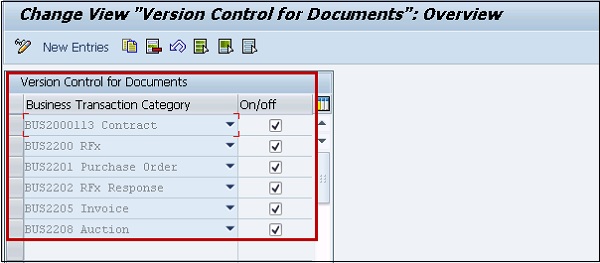
Step 5 − To display change documents and to compare versions of a central contract, click on Tracking when you display the central contract.
Uploading and Managing Central Contracts in ERP
Let us now understand how to upload and manage central contracts in ERP. You can upload contracts in SAP ERP system by going to SAP ERP Central Component → Logistics → Materials Management → Purchasing → Outline Purchase agreements with vendors → Contract → Central Contract → SRM Central Contract
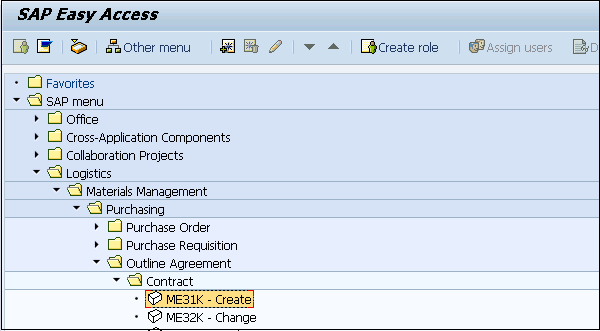
Managing Authorization in Central Contract
In SAP ERP, it is possible to authorize users to assign a role to create, change or display a central contract in repository. Companys law department analyzes the agreement before it is released for users. You can assign a role display/change to the legal team to view notes with no access to confidential fields like terms and conditions.
Let us follow these steps to assign a role display/change −
Step 1 − To assign the authorization for Central Contract, go to SAP SRM → Strategic Purchasing → Contract Management → Contract.
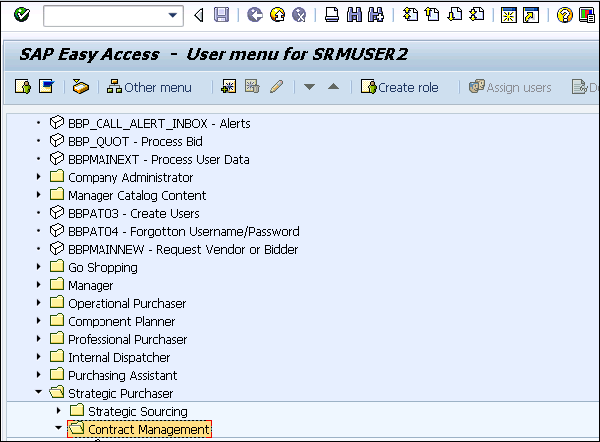
Step 2 − If you are not able to call this transaction from SAP Easy access, you can go SRP portal and go to Strategic Purchasing tab.
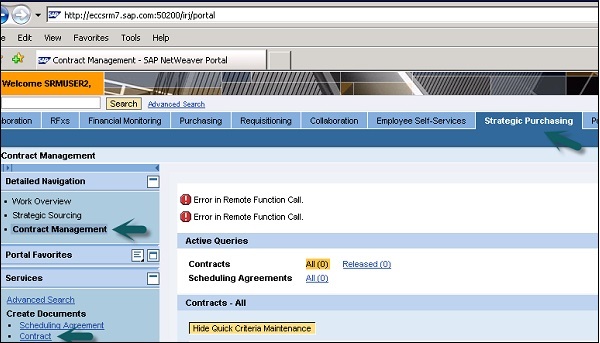
Step 3 − You have to go to Authorization tab → To edit an existing user, select a user and edit.
You can create a new user and assign the authorization as per the requirement of the user.

Performing Changes in Central Contract
You can perform same changes to one or more central contracts or to a central contract hierarchy. This is used to perform mass changes to multiple contracts as per business needs.
Example
Consider a case where you have multiple contracts with a Supplier ABC. Now with increase in order volume, you will get an additional discount of x%. Now to maintain multiple contracts with this supplier ABC, you have to change all contracts at one time.
Note
You cant make changes to central contracts which are marked as completed.
To make mass changes for central contract, you have to search and select contracts in central repository.
To perform mass change, go to mass change option and it will open the wizard.
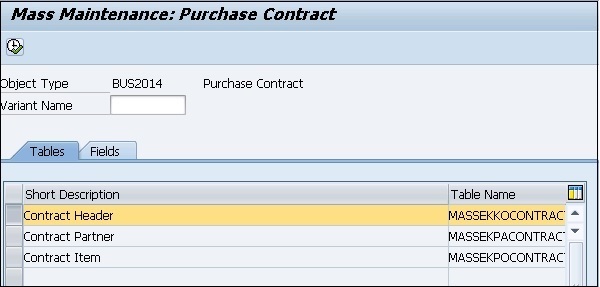
You can see all the contracts that you have selected. To perform a mass change, select mass change parameter and specify the change and same way select other mass change parameters and specify the change.
You can see a flag next to all those fields for which parameter has been changed and this indicates that you have changed this parameter. All the contracts in Wizard remain locked when you are performing mass changes so that no other user makes changes to these projects.
It is also possible to perform the changes in background as the time required to perform changes depends on the number of central contracts and you can close the Mass Change window. Once changes are completed, you will get an email with the link of mass changes completed. You can view if changes are applied successfully or not.